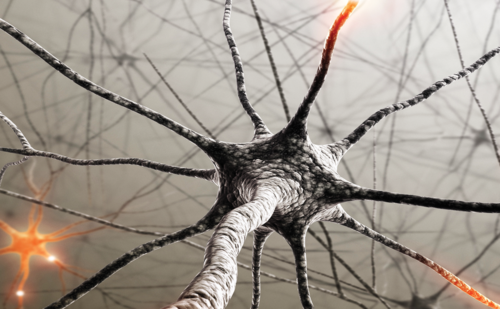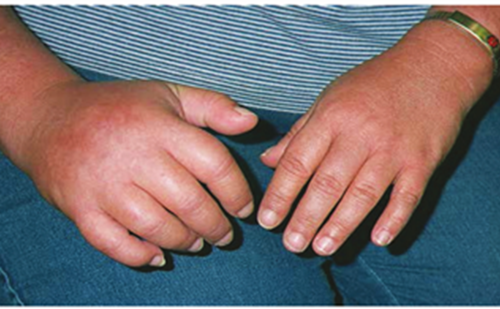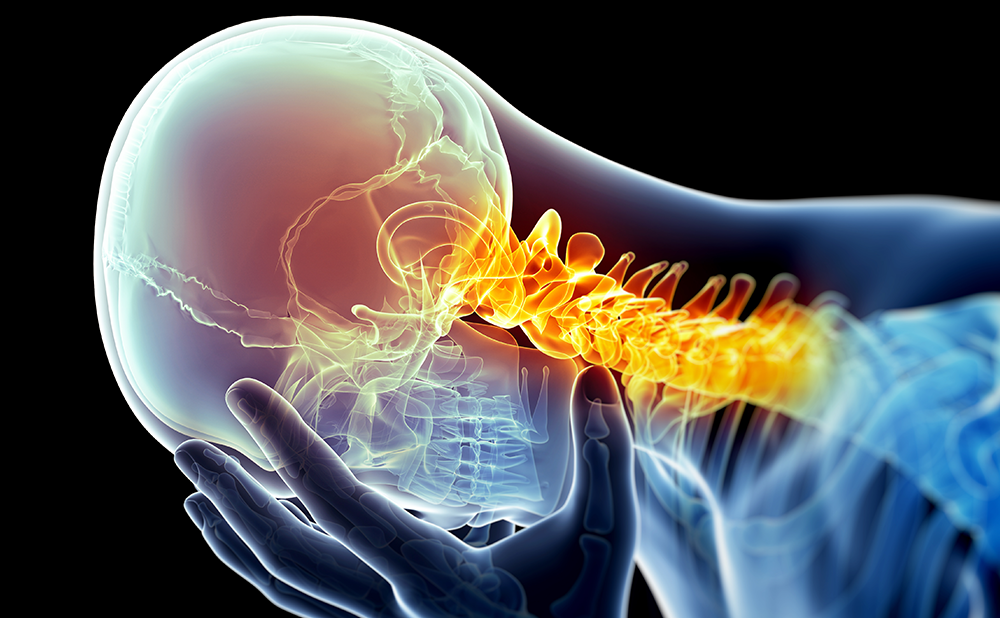Until the 1980s, central neuropathic pain (CNP) was mainly viewed as a ‘release’ phenomenon caused by a lesion that removed inhibitory influences of the lemniscal pathways on pain systems.1–3 However, detailed sensory analysis of CNP patients later demonstrated that almost all cases had lesions affecting the major pathways for temperature and pain sensation (the spino-thalamo-cortical pathways), while concomitant injury to the medial lemniscal system was not essential for the development of CNP.4 Accordingly, impairment of spinothalamic pathways is now regarded as a crucial or even sine qua non condition for the occurrence of CNP.4–8
However, damage to the nociceptive pathways is not a sufficient condition for CNP to occur, as lesions entailing identical deficits may induce chronic pain in some subjects and not in others.6–9 These differences may arise in part from genetic susceptibility10 and in part from pathophysiological dissimilarities that are not detected by standard clinical exams, but may be disclosed by more sophisticated analyses. The proteiform nature of mechanisms triggered by a given lesion is supported by the variety of physiological responses that can be obtained in patients with similar anatomical damage. This has prompted the search for neurophysiological techniques selective for spinothalamic pathways and powerful enough to detect subtle abnormalities in their function.
The Problem of Selective Stimulation of Nociceptive Afferents
Standard neurophysiological responses, i.e. nerve conduction studies and somatosensory-evoked potentials (SEPs), do not selectively assess the function of the thin fibres that convey pain sensations, because electrical stimuli preferentially excite the large, non-nociceptive afferents with the lowest electrical threshold (Aα and Aβ fibres). Special techniques have been proposed to improve the selectivity of electrical stimuli for pain pathways, such as selective blocks of large fibres11–12 and intra-neural or intra-epidermal stimulation.13–14
However, all of these techniques have significant technical limitations, are confined to restricted territories and whether they provide a reliable specific correlate of the nociceptive input is controversial. Radiant-heat stimulation can circumvent these difficulties by providing selective activation of Aδ and C thermosensitive nociceptors, without concomitant activation of mechano-receptors. However, most common sources of thermal stimulation, such as light bulbs or Xenon lamps, cannot activate nociceptors synchronously enough to allow the recording of neurophysiological responses.15
Monochromatic high-intensity light sources provided by laser stimulators eliminate most of these problems. Laser stimulators are able to deliver brief (1–100ms) pulses that rapidly raise the temperature in the superficial layers of the hairy skin and excite type II mechano-thermal nociceptors related to small myelinated (AMH) or unmyelinated (CMH) fibres, as well as thermal C receptors (C warmth units). Gas-state (CO2, argon) or solid-state laser stimulators – yttrium aluminium garnet (YAG) or yttrium aluminum perovskite (YAP) – are the most commonly used.
Although laser stimuli most often simultaneously excite Aδ and C receptors, both the sensation and the concomitant laser-evoked cerebral potentials (LEPs) reflect, almost exclusively, the transmission by Aδ channels. The reason for this is beyond the purpose of this paper, but the interested reader can consult detailed papers on this matter.16–17 Selective excitation of the amyelinic C fibres can be achieved by diverse procedures, mainly based on the elimination of the Aδ component by a pressure-block,18 stimulation of tiny skin areas19 or stimulation of large areas at low intensity.20–21 All of these manipulations yield the so-called ‘ultra-late’ LEPs, rising to about 1,000ms after stimulation and depending exclusively on C-fibre activation.
Laser-evoked Potentials in Central Neuropathic Pain
The value of LEPs in the diagnosis of neuropathic pain relies on their aptitude to detect dysfunction of pain and temperature pathways, which is the basis of CNP syndrome development. During the 1990s, extensive validation efforts were carried out to record LEPs in proven lesions of the nervous system, which showed that LEPs can detect even minute injury of the spinothalamic pathways provided that the stimulus is correctly applied to the affected regions. This has been shown for spinal, brainstem, thalamic and thalamo-cortical lesions;22,23 it is now reasonable to assert that if one central nervous system (CNS) lesion is able to induce a deficit in pain and temperature perception, it will also be able to alter the LEPs. In cases of dissociated sensory loss, LEPs are abnormal while conventional SEPs exploring the dorsal column–medial lemniscal system commonly remain within normal limits.24–26 In general terms, there is a strict overlap between conditions that are able to decrease LEPs and those able to induce neuropathic pain.
On the basis of studies published so far, the European Federation of Neurological Societies (EFNS) has recommended the use of LEPs as an ancillary tool in the evaluation of neuropathic pain, and regrets that few university hospitals currently use this technique.27 The main points relevant to the use of LEPs in the diagnosis and management of neuropathic pain are summarised below.
Abnormal Laser-evoked Potentials to Stimulation of a Painful Territory Substantiate the Neuropathic Nature of the Pain
Attenuated, delayed or absent LEPs to stimulation of a painful territory (while remaining normal to stimulation of non-painful sites) reveal transmission abnormalities in the pain pathways, and make the condition enter the framework of neuropathic pain.27 In central pain, LEPs are attenuated to the stimulation of the painful territory, even if the patients present enhanced pain reactions such as hyperalgaesia or allodynia.28–30 The reason for this is that LEPs index the activity of the most synchronised and rapidly transmitted pain and temperature volleys. This system mediates elaborated and discriminative aspects of nociception and is subserved by the ‘lateral’ or ‘neo-spinothalamic’ arrangement of spinal tracts and thalamocortical projections, whose lesions are well reflected by LEPs.
The cortical networks that generate LEPs are able to detect abrupt changes in sensory input, but are much less qualified to reflect a slow-changing state. Thus, LEPs are inappropriate to reflect the slowly emerging, ill-defined and long-lasting phenomena that underlie over-reaction symptoms (hyperalgaesia and allodynia), which are thought to depend on spino-reticulo-thalamic projection systems.31–33 In other words, the slope of energy change associated to allodynic or hyperalgaesic symptoms is commonly not abrupt enough to generate LEPs. Thus, LEPs accurately reflect the spinothalamic deafferentation leading to pain discrimination deficits, but do not index the neural events underlying allodynia and hyperalgaesia. This is the electrophysiological counterpart of a clinical paradox commonly observed in CNP syndromes, namely the presence of exaggerated pain reactions within territories where pain discrimination is decreased or abolished.7 However, we shall see that some patterns of LEP abnormality may indirectly reflect the existence of hyperalgaesic symptoms (see below).
Normal Laser-evoked Potentials Argue Against the Diagnosis of Central Neuropathic Pain
Although we ignore how much spinothalamic damage is still compatible with a normal LEP response, available data suggest that the sensitivity of LEPs parallels that of a detailed neurological exam. LEPs have been found to be abnormal in patients with even discrete sensory loss due to peripheral or central damage.28,34 Normal LEPs are obtained in patients with conversion disorder or malingering or nonorganic pain,30,35 but have never been described in the presence of thermal hypesthaesia due to a proven lesion of pain pathways. Some reports suggest that LEPs may be sensitive enough to detect deficits that are suspected because of the history, symptoms or other aspects of the neurological examination, but are not revealed by quantitative sensory testing.28,36 Inasmuch as central pain without pain and temperature sensory deficits is exceptional, the recording of normal LEPs to stimulation of a painful territory stands clearly, in most cases, against the diagnosis of CNP (see Figure 1).
However, there are instances where central pain may present without clinically evident spinothalamic deficits. For instance, the patient may be unable or unwilling to collaborate with a clinical examination. In such cases, LEPs are helpful to confirm diagnosis by demonstrating objective spinothalamic deficits (see Figure 2). Moreover, sensory deficits may sometimes exclusively concern the dorsal column–medial lemniscus system. These pure lemniscal lesions are rare sources of CNP.37,38 In these cases, standard SEPs will highlight deficiencies and attest to the neuropathic origin of the pain. In rare cases, a proven CNS lesion may transitorily induce pain with genuine central features, but without any clinical or electrophysiological evidence of sensory loss.39 However, these are exceptional cases. In the vast majority of patients with pain and normal LEPs, the characteristics of the pain will not match those observed in neuropathic pain; for instance, pain will be ill-defined, with an absence of neurological distribution. Most of these patients will eventually enter a category of pseudo-neuropathic pain that includes (not exhaustively) fibromyalgia, myofascial syndromes, somatoform disorders and malingering, and will be ameliorated by targeted interventions.
Laser-evoked Potentials Abnormalities Depend on Both Lesion Site and Pain Physiopathology
Stroke at sites where the spinothalamic tract (STT) fibres are compacted (e.g. Wallenberg’s syndrome) tend to create more profound LEP disruption than focal lesions affecting only one subcontingent of spinothalamic axons, e.g. lacunar thalamic syndromes.40 Conditions with sudden onset and progression, such as ischaemic lesions, tend to affect more LEPs than disorders that deform neural structures without important axonal loss, as observed in slowly progressing syringomyelia.
Although LEPs are unable to reflect directly the long-term constant changes associated with hyperalgaesic and allodynic phenomena, they may reflect indirectly the presence of such over-reactions. This notion is supported by the fact that LEPs are significantly less attenuated in patients showing allodynia or hyperalgaesia than in those with exclusively spontaneous pain,28,30 suggesting that partial preservation of pain and temperature pathways fosters the development of stimulus-induced pain.
Similar findings are provided by quantitative sensory testing (QST), which shows relative preservation of thermo-algaesic function in patients with spinal lesions and allodynia.41 Tasker et al.31 proposed that the STT and the adjacent spinoreticulothalamic tract (STT–SRT) interact in such a way that partial deafferentation of the former renders the reticulothalamic system responsive to stimulation, provoking painful sensations. While complete abolition of LEPs suggests a complete STT–SRT lesion, abnormal but partially preserved LEPs may reflect abnormal pain responsiveness through disinhibition of the spino-reticulo-thalamic component and its medial thalamic targets.33,42 In central pain patients this LEP pattern consists of abnormally delayed, desynchronised and ill-defined responses.28–30
Future Challenges
During the past decade, LEPs have gained a place in the neurological diagnostic armamentarium for neuropathic pain. Chronic pain conditions can now be classified as either affecting or non-affecting LEPs. While pain conditions affecting LEPs can definitely be considered as neuropathic, non-affecting pain conditions should be regarded within a wide range of non-neuropathic entities, including fibromyalgia, chronic fatigue syndrome, tension headache, migraine, type I complex regional pain syndrome (CRPS) and somatoform pain disorders. The objective nature of evoked potentials is an obvious advantage compared with language-mediated or behavioural tests, including thermode-based sensory testing, the results of which can be influenced by malingering, unconscious bias and other psychological factors.43
Although LEPs have shown their capacity to assist in the diagnosis of CNP, it is not yet known whether they can also help to identify patients who, not being yet in pain, are likely to develop a neuropathic pain condition. About 18% of stroke patients with initial somatosensory deficit will eventually develop neuropathic pain.44 This figure increases to 25–60% in syringomyelia or brainstem infarcts.33,37 As pain usually does not develop immediately but commonly one to six months after the triggering event, preventative therapy may be attempted early if we could reliably determine those patients prone to develop neuropathic pain.
A number of teams are actively working on this matter, and preliminary results indicate that the processing of LEPs with sophisticated procedures such as time-frequency analysis45 may disclose subgroups of patients with the highest probability of presenting CNP after stroke. This, along with the prediction of therapeutic success of motor cortical stimulation,46 could be one of the biggest avenues towards the use of electrophysiological methods, not only for assessment, but also for prevention of CNP. ■













